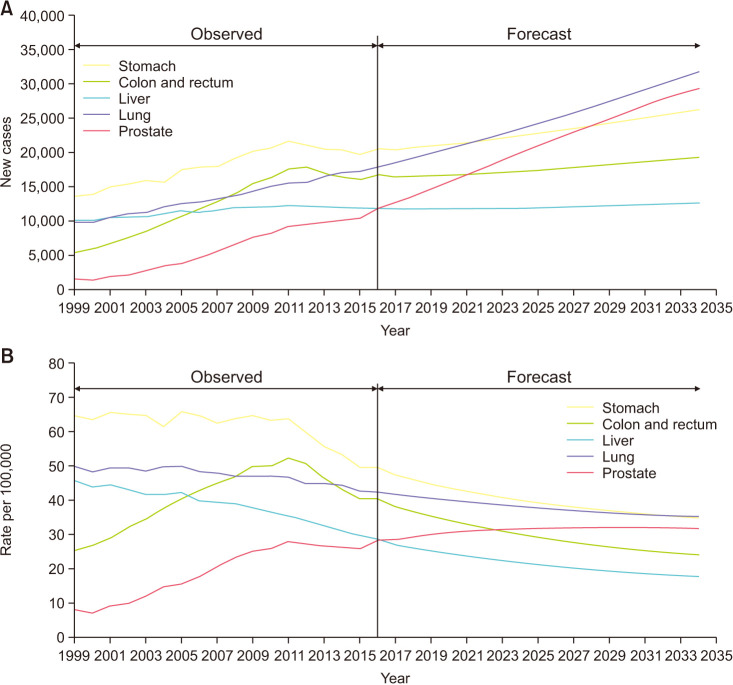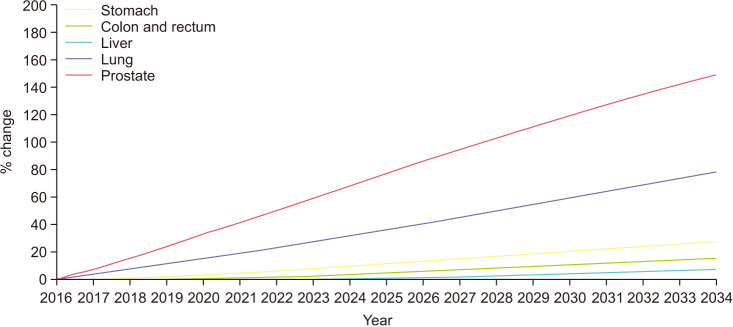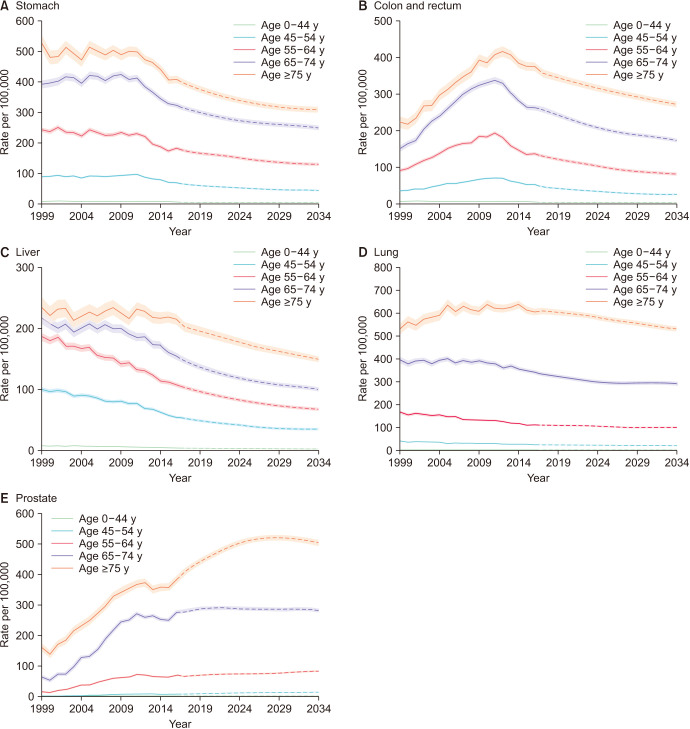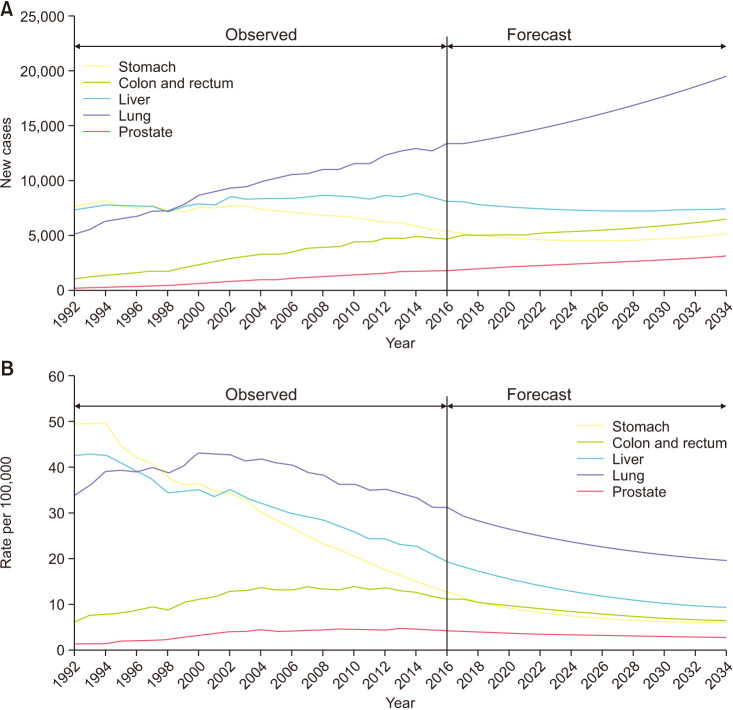Abstract
Purpose
The Korean population is rapidly aging, and the cancer burden is expected to change significantly. This study aimed to generate projections of incidence and mortality of major cancers among men in Korea until 2034, with a special focus on prostate cancer.
Materials and Methods
Cancer incidence data from 1999 to 2016 were obtained from the Korea National Cancer Incidence Database. Mortality data were obtained from Statistics Korea. The most common cancers among Korean men (stomach, colorectum, liver, lung and prostate) were analyzed. To predict the future trends of these cancers, the age-period-cohort method was conducted and extrapolated up to 2034.
Results
In Korean men, prostate cancer was the fourth most commonly diagnosed cancer in 2016. Based on newly diagnosed cases, the leading cancer site in the year 2034 is expected to be the lung, and the prostate is expected to be the second most frequently diagnosed cancer among Korean men. Age-standardized incidence rates of the most common cancers in men, except prostate cancer, are expected to decrease until 2034. Lung cancer is projected to remain the most common cause of cancer-related mortality until 2034, and the highest estimated change in cancer deaths is expected to be for prostate cancer.
Conclusions
In Korea, the incidence and mortality of prostate cancer is expected to increase markedly in the period up to 2034, particularly in older men. Concerted efforts in screening, diagnosis, and treatment strategies should be considered by healthcare planners and providers.
Keywords: Forecasting, Incidence, Mortality, Prostate cancer
Graphical Abstract
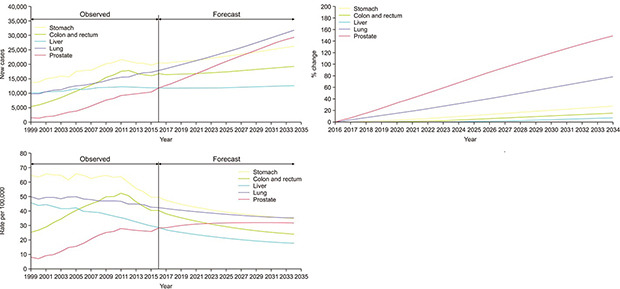
INTRODUCTION
The global cancer burden is rapidly growing, with 18.1 million new cases and 9.6 million cancer deaths in 2018 [1]. In Korea, 229,180 new cancer cases were diagnosed and death from cancer accounted for 27.8% of all deaths in 2016 [2]. The Korean population is one of the most rapidly aging in the world [3], and according to data published by Statistics Korea [4], the number of people aged ≥65 years is expected to increase from approximately 3.0 million in 2017 to approximately 6.8 million in 2034. In addition, Korea is likely to have the life expectancy frontier position for men and women by 2030 among 35 industrialized countries [5]. Considering the relationship between aging and cancer incidence, the cancer burden is expected to increase in Korea. A projection of the future cancer burden is therefore urgently needed to facilitate informed prioritization and health policy development, and guide cancer research and treatment.
Prostate cancer is the second most frequently diagnosed cancer and the fifth leading cause of cancer related death in men worldwide [1]. Risk factors for prostate cancer are heterogeneous, and include age, ethnicity, genetic mutation, family history, and a westernized diet [6,7]. Of these, age is most strongly associated with the development of prostate cancer. The median age at diagnosis is 67 years, and diagnosis before the age of 50 years is rare [8]. The incidence rate of prostate cancer varies more than 25-fold worldwide and is generally higher in Westernized countries than in Asian countries [6,7]. However, the incidence of prostate cancer has grown rapidly in recent years in East Asia, and East Asian men currently account for 23.3% of cases of prostate cancer globally [9]. In Korean men, prostate cancer is the fourth most commonly diagnosed cancer and the tenth leading cause of cancer related death, with an estimated 11,800 new cases diagnosed and 1,745 deaths in 2016 [2]. Notably, the incidence of prostate cancer in Korea has risen rapidly over the past two decades [10], and due to the rapid demographic shifts, the burden of prostate cancer in Korea is expected to increase markedly in the future.
The aim of the current study was to generate projections of major cancer incidence and mortality among men in Korea until 2034, with a special focus on prostate cancer.
MATERIALS AND METHODS
1. Study data
The Korea Central Cancer Registry (KCCR) is a nationwide hospital-based cancer registry that was established in 1980 by the Ministry of Health and Welfare. Detailed information on the history and activities of the KCCR have been described elsewhere [2,11]. Nationwide cancer incidence data have been collected by the KCCR since 1999, including information on age, sex, region, date of diagnosis, topography, and histological type. The completeness of cancer incidence data for 2016 was estimated to be 98.2% [2].
We used cancer incidence data for the five common cancers from 1999 to 2016 using the national cancer incidence data. All cancer cases were registered in accordance with the third edition of the International Classification of Diseases for Oncology, and converted to the tenth edition of the International Classification of Diseases (ICD-10) [12,13]. Mortality data from Statistics Korea were used from 1992 to 2017. Cases of mortality were registered in accordance with the ICD-10. We used data for stomach (ICD-10: C16), colon and rectum (ICD-10: C18–C20), liver (ICD-10: C22), lung (ICD-10: C33–C34), and prostate (ICD-10: C61). Patients with cancer were categorized into five groups based on their ages in years; <45, 45–54, 55–64, 65–74, and ≥75.
Population parameters were obtained from the population estimation and projections from 1992 to 2034, categorized by 5-year age group and sex reported by Statistics Korea 2034. The study protocol was approved by the Institutional Review Board of the National Cancer Center, Korea (approval number: NCC2020-0128).
2. Statistical analysis
The age-specific rates for the selected cancers were modeled using the age-period-cohort method proposed by Sasieni and Adams [14] and extrapolated up to 2034. A Poisson regression model was used to estimate the age, period, and cohort effect. The model assumes that the number of cancer cases follows a Poisson distribution, and the incidence/mortality rates are a multiplicative function of the included model parameters. The basic age-period-cohort model is as follows:
where λ, incidence (mortality) rate as a function of age and calendar period; g , “link” function; fA, function of age; fP, function of period (year of incidence or mortality); fC, function of cohort (year of birth, i.e., cohort=period-age). We used the exponential function [15] as the link function, functions fA, fP, and fC are the cubic spline to provide greater flexibility and more realistic data. The different numbers of interior knots were used for the three temporal effects; 6 knots for age effects, 5 knots for period effects, and 3 knots for cohort effects.
The number of cases in Korea in each 5-year age group was multiplied by the corresponding age-specific rates to estimate the numbers of cases. Age-standardized rates (ASRs) were expressed per 100,000 individuals. ASR is a weighted average of the age-specific rates, where the weights are the proportions of people in the corresponding age-groups in an entire population [16]. In the present study, ASRs were calculated using Segi’s world standard population [17].
Trends in ASRs were summarized as annual percentages of change (APCs) and average annual percent change (AAPC). APC is the average percentage change (PC) of ASRs and is calculated as follows [16], where y=year, b0=intercept, b1=slope, log(Ry)=b0+b1y, and log(Ry) is the natural log transformed age standardized rates.
AAPC was defined as a summary measure of the trend over a pre-specified interval: 1999–2016 and 2017–2034. AAPC is calculated as a weighted average of the APCs from the joinpoint model, with the weights to the length of the APC interval.
All analyses were conducted using SAS version 9.4 (SAS Institute Inc., Cary, NC, USA), Stata version 16.1 (StataCorp, College Station, TX, USA) and Joinpoint version 4.7 (National Cancer Institute, Bethesda, MD, USA), and p<0.05 was used for statistical significance.
RESULTS
From 1999 to 2016 the Korean population grew by 9.9%, from 46 million to 51 million (Fig. 1). The annual incidence of the most common cancers (stomach, colorectum, liver, lung, and prostate) in men increased by 96.1% over the same period, from 40,056 to 78,544 (Table 1). From 2017 to 2034, the Korean population is expected to grow by 0.7%, whereas a 109.2% increase in the number of people aged ≥65 years is expected, from 7 million to 15 million (Fig. 1). Over that same period the annual incidence of the most common cancers in men is expected to increase by 49.8% (Table 1).
Fig. 1. Population projections of Korea.
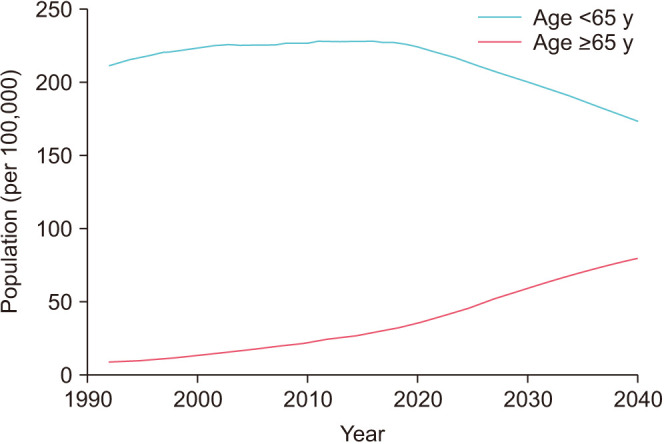
Table 1. Incident cases and age-standardized rate of the selected five cancers up to 2034.
| Cancer site | Case | ASR | |||||||||
|---|---|---|---|---|---|---|---|---|---|---|---|
| 1999 | 2016 | 2034 | Changes 2016–2034 | 1999 | 2016 | 2034 | Changes 2016–2034 | ||||
| Total (PC) | Annual (AAPC) | Total (PC) | Annual (AAPC) | ||||||||
| All ages | |||||||||||
| Stomach | 13,554 | 20,509 | 26,145 | 27.5 | 1.5 | 64.6 | 49.7 | 34.8 | -29.9 | -1.9 | |
| Colon and rectum | 5,310 | 16,672 | 19,204 | 15.2 | 0.9 | 25.5 | 40.4 | 24.0 | -40.5 | -2.7 | |
| Liver | 10,017 | 11,774 | 12,588 | 6.9 | 0.3 | 45.7 | 28.5 | 17.8 | -37.5 | -2.7 | |
| Lung | 9,738 | 17,789 | 31,669 | 78.0 | 3.2 | 49.8 | 42.3 | 35.3 | -16.6 | -1.0 | |
| Prostate | 1,437 | 11,800 | 29,339 | 148.6 | 5.4 | 8.1 | 28.3 | 31.7 | 12.1 | 0.8 | |
| Age <65 y | |||||||||||
| Stomach | 8,300 | 10,417 | 7,597 | -27.1 | -1.6 | 34.3 | 25.4 | 16.4 | -35.3 | -2.3 | |
| Colon and rectum | 3,213 | 8,024 | 4,695 | -41.5 | -2.8 | 13.3 | 19.7 | 10.1 | -48.6 | -3.5 | |
| Liver | 7,301 | 6,757 | 4,428 | -34.5 | -2.4 | 30.2 | 16.5 | 9.9 | -39.9 | -2.9 | |
| Lung | 4,434 | 5,353 | 5,192 | -3.0 | -0.1 | 19.3 | 13.2 | 10.6 | -19.1 | -1.2 | |
| Prostate | 334 | 2,843 | 4,058 | 42.7 | 2.3 | 1.5 | 7.0 | 8.1 | 15.2 | 1.1 | |
| Age ≥65 y | |||||||||||
| Stomach | 5,254 | 10,092 | 18,548 | 83.8 | 3.4 | 30.1 | 24.3 | 18.4 | -24.2 | -1.5 | |
| Colon and rectum | 2,097 | 8,648 | 14,510 | 67.8 | 3.0 | 12.2 | 20.7 | 13.9 | -32.8 | -2.1 | |
| Liver | 2,716 | 5,017 | 8,160 | 62.6 | 2.8 | 15.5 | 12.0 | 7.9 | -34.2 | -2.3 | |
| Lung | 5,304 | 12,436 | 26,477 | 112.9 | 4.2 | 30.4 | 29.2 | 24.7 | -15.4 | -0.9 | |
| Prostate | 1,103 | 8,957 | 25,281 | 182.2 | 6.0 | 6.6 | 21.3 | 23.6 | 11.1 | 0.7 | |
ASR, age-standardized rate; PC, percent change; AAPC, average annual percent change.
The observed and projected incidence values by cancer location in men are shown in Table 1. Based on our projections, the incidence of lung cancer will become the most frequently diagnosed cancer in Korean men by 2034 (Fig. 2A). Prostate cancer will be the second most frequently diagnosed cancer in Korean men by 2034, exceeding the incidence of colorectal and stomach cancer. Furthermore, ASRs of the incidence of the most common cancers in men, except prostate cancer, are expected to decrease from 2016 to 2034 (Fig. 2B). The ASR of prostate cancer will surpass liver and colorectal cancer, thus ranking third by 2034 in Korean men.
Fig. 2. The observed and projected incidence of (A) new cases and (B) age-standardized for men in Korea.
Based on the absolute number of cases for cancer incidence, cancer sites with the highest increases from 2016 to 2034 in men are expected to be the prostate (PC: 148.6%), followed by cancer of the lung (78.0%), stomach (27.5%), colorectum (15.2%), and liver (6.9%) (Fig. 3). In men aged ≥65 years, new cases from 2016 to 2034 are expected to increase for every cancer site analyzed, and the increase is much larger than in other age groups. The sites with the highest increases are expected to be the prostate (PC: 182.2%), lung (112.9%), stomach (83.8%), colorectum (67.8%), and liver (62.6%) in men aged ≥65 years (Table 1). In men aged <65 years, predicted incidence rates of the four major cancers are decreased from 2016 to 2034, except for prostate cancer (PC: 42.7%) By age group (Fig. 4), only prostate cancer had an increasing ASR for incidence up till 2034 in men aged <65 (15.2%) and ≥65 years (11.1%).
Fig. 3. Projected change in new cases from 2016 to 2034 (as percentages of the 2016 value).
Fig. 4. Age-standardized incidence rates for the selected five cancers in men by age group up till 2034. (A) Stomach. (B) Colon and rectum. (C) Liver. (D) Lung. (E) Prostate.
The observed and projected mortality values by cancers are shown in Table 2. Lung cancer is projected to remain the most common cause of cancer-related mortality among Korean men, and the absolute number of deaths is likely to steadily increase (Fig. 5A). The highest estimated change in cancer deaths from 2016 to 2034 is expected to be for prostate cancer (PC: 75.0%), followed by cancer of the lung (46.4%), colorectum (37.7%), stomach (-3.0%), and liver (-9.0%). ASR of mortality of all of the most common cancers in men are expected to decrease (Fig. 5B). Lung cancer is expected to have the highest ASR for mortality until 2034, followed by cancer of the liver, colorectum, stomach and prostate.
Table 2. Mortality cases and age-standardized rate of the selected five cancers up to 2034.
| Cancer site | Case | ASR | |||||||||
|---|---|---|---|---|---|---|---|---|---|---|---|
| 1992 | 2016 | 2034 | Changes 2016–2034 | 1992 | 2016 | 2034 | Changes 2016–2034 | ||||
| Total (PC) | Annual (AAPC) | Total (PC) | Annual (AAPC) | ||||||||
| All ages | |||||||||||
| Stomach | 7,603 | 5,318 | 5,158 | -3.0 | -0.2 | 49.4 | 12.6 | 6.0 | -52.6 | -4.3 | |
| Colon and rectum | 962 | 4,659 | 6,413 | 37.7 | 1.6 | 6.1 | 10.9 | 6.2 | -42.8 | -3.3 | |
| Liver | 7,247 | 8,043 | 7,316 | -9.0 | -0.7 | 42.5 | 19.2 | 9.3 | -51.7 | -4.1 | |
| Lung | 5,060 | 13,323 | 19,503 | 46.4 | 2.2 | 33.8 | 31.1 | 19.6 | -36.9 | -2.5 | |
| Prostate | 160 | 1,745 | 3,053 | 75.0 | 3.1 | 1.3 | 4.0 | 2.5 | -36.8 | -2.6 | |
| Age <65 y | |||||||||||
| Stomach | 4,379 | 1,845 | 1,051 | -43.0 | -3.0 | 23.4 | 4.5 | 2.1 | -52.5 | -4.2 | |
| Colon and rectum | 573 | 1,425 | 616 | -56.8 | -4.6 | 2.9 | 3.5 | 1.3 | -62.9 | -5.5 | |
| Liver | 5,468 | 3,909 | 1,956 | -50.0 | -3.8 | 28.4 | 9.5 | 4.3 | -55.0 | -4.5 | |
| Lung | 2,747 | 2,879 | 2,065 | -28.3 | -1.7 | 15.4 | 7.1 | 4.1 | -41.4 | -3.0 | |
| Prostate | 30 | 141 | 73 | -47.9 | -3.5 | 0.2 | 0.4 | 0.1 | -60.1 | -4.9 | |
| Age ≥65 y | |||||||||||
| Stomach | 3,224 | 3,473 | 4,107 | 18.3 | 0.7 | 26.0 | 21.3 | 3.8 | -52.6 | -4.3 | |
| Colon and rectum | 389 | 3,234 | 5,797 | 79.3 | 3.0 | 3.2 | 7.4 | 4.9 | -33.4 | -2.4 | |
| Liver | 1,779 | 4,134 | 5,359 | 29.6 | 1.4 | 14.1 | 9.7 | 5.0 | -48.5 | -3.7 | |
| Lung | 2,313 | 10,444 | 17,438 | 67.0 | 3.0 | 18.4 | 24.0 | 15.5 | -35.5 | -2.3 | |
| Prostate | 130 | 1,604 | 2,980 | 85.8 | 3.3 | 1.1 | 3.6 | 2.4 | -34.3 | -2.3 | |
ASR, age-standardized rate; PC, percent change; AAPC, average annual percent change.
Fig. 5. The observed and projected mortality of (A) new cases and (B) age-standardized for men in Korea.
DISCUSSION
Projection of the cancer burden is important in terms of healthcare policy development, resource allocation, and research [18]. There is a 95% probability that in 2030 life expectancy at birth among Korean men will be over 80 years [5]. Rapid demographic shifts in Korea are expected to exert pressure on the components of the healthcare system related to cancer, highlighting the profound importance of estimating the future cancer burden. Of the cancers that are most common in Korean men, prostate cancer may be the most affected by the aging society given the strong association between age and incidence.
There are previous reports of ethnic and international variations in prostate cancer incidence and mortality rates [1,7]. Genetic factors and healthcare accessibility reportedly contribute to these variations. The worldwide burden of prostate cancer with respect to new cases and deaths is expected to increase approximately two-fold by 2040 simply due to population growth and aging [19]. In one recent report, it was surmised that prostate cancer incidence rates have stabilized or been in decline in most countries, and decreases were more pronounced in high-income countries [7]. Notably, however, incidence rates of prostate cancer have continued to increase in Asia and some Eastern European countries.
Korea is one of the most rapidly aging societies in the world, and some East Asian countries are experiencing similar changes [20,21,22]. In Japan, where population aging began earlier, the incidence rate of prostate cancer is expected to increase dramatically from 103,610 in 2015–2019 to 180,860 in 2035–2039 (a 74.6% increase), whereas the incidence rates of other common cancers in men (stomach, liver, lung, and colon) are expected to stabilize or decline during the same period [23].
Our study shows that the incidence of prostate cancer in Korea can be expected to increase markedly in the years up till 2034, particularly in older men aged ≥65 years. To our knowledge, this study is the first to generate a long-term forecast of the future burdens exerted by cancers in Korean men based on national cancer registry data. From 2016 to 2034, the total projected prostate cancer incidence is predicted to increase by 148%. The incidence in elderly men drive this increase, with a 182.2% increase in men aged ≥65 years. Notably, prostate cancer is the only cancer commonly diagnosed in men, the incidence of which is predicted to steadily increase in ASR in Korea. While age-specific rates are expected to decrease across all age groups for the other cancers, prostate cancer is expected to increase or be stable. The change in the cases of mortality from prostate cancer is relatively small, but also expected to increase by 75.0% from 2016 to 2034, particularly prominent in men aged ≥65 years.
Countries throughout the East Asia are experiencing similar demographic transitions, and are likely to have similar rapid increases in the burden of prostate cancer [20,21,24]. The screening, diagnosis and treatment activities for prostate cancer in Asia are guided based on the data of the western population mostly [22,25]. However, several studies have reported that prostate cancer in Asian men is usually advanced by the time that it is diagnosed [26,27], and that the genetic alterations differ markedly from those found in Western men [28]. Therefore, caution should be exercised about extrapolating data from Western populations to Asian populations, and concerted efforts are needed to develop strategies for the prevention, screening, diagnosis, and treatment of prostate cancer based on epidemiological and sociodemographic factors. First, the pros and cons of prostate-specific antigen (PSA)-based screening should be investigated in Asian populations. PSA-based screening is a simple, sensitive, and inexpensive detection tool for prostate cancer that has been widely adopted [22]. However, its role in the reduction of mortality, which is mostly due to aggressive disease, is controversial and routine screening for prostate cancer in all men may drive overdiagnosis and overtreatment [29]. Contrary to Western populations, there are no published prospective controlled studies of prostate cancer screening in Asian men. Currently, there are no official guidelines on screening for prostate cancer available in Asian countries other than Japan [22]. Second, tailored prostate cancer management strategies are needed in the national healthcare system. Considering the heterogeneous nature of prostate cancer, strategies to reduce its overdiagnosis and overtreatment, and to improve the detection of clinically significant disease in Asian men, should be developed and validated, using methods such as magnetic resonance imaging-targeted prostate biopsy, active surveillance programs, and genetic marker-based approaches.
The present study is not free from limitations. A major limitation of the present study is that prostate cancer stage-specific projection was not performed due to a lack of available information in that regard.
CONCLUSIONS
In conclusion, in Korea, the incidence and mortality of prostate cancer is expected to increase markedly in the period until 2034, due primarily to estimated increases in the aged population. Concerted efforts to develop, implement, and maintain screening, prevention, and treatment strategies should be considered by healthcare planners and providers.
Footnotes
CONFLICTS OF INTEREST: The authors have nothing to disclose.
FUNDING: This study was funded by the Korean Urological Oncology Society (2019-02) and the National Cancer Center, Korea (170085 and NCCCDA2019-06).
- Research conception and design: Sahyun Pak, Kyu-Won Jung, and Jae Young Joung.
- Data acquisition: Kyu-Won Jung, Eun-Hye Park, and Young-Joo Won.
- Statistical analysis: Kyu-Won Jung and Eun-Hye Park.
- Data analysis and interpretation: Sahyun Pak, Kyu-Won Jung, Eun-Hye Park, and Jae Young Joung.
- Drafting of the manuscript: Sahyun Pak and Kyu-Won Jung.
- Critical revision of the manuscript: Young Hwii Ko and Jae Young Joung.
- Obtaining funding: Sahyun Pak and Jae Young Joung.
- Supervision: Jae Young Joung.
- Approval of the final manuscript: Sahyun Pak, Kyu-Won Jung, and Jae Young Joung.
References
- 1.Bray F, Ferlay J, Soerjomataram I, Siegel RL, Torre LA, Jemal A. Global cancer statistics 2018: GLOBOCAN estimates of incidence and mortality worldwide for 36 cancers in 185 countries. CA Cancer J Clin. 2018;68:394–424. doi: 10.3322/caac.21492. Erratum in: CA Cancer J Clin 2020;70:313. [DOI] [PubMed] [Google Scholar]
- 2.Jung KW, Won YJ, Kong HJ, Lee ES. Cancer statistics in Korea: incidence, mortality, survival, and prevalence in 2016. Cancer Res Treat. 2019;51:417–430. doi: 10.4143/crt.2019.138. [DOI] [PMC free article] [PubMed] [Google Scholar]
- 3.Kim SH, Kim DH, Kim WS. Long-term care needs of the elderly in Korea and elderly long-term care insurance. Soc Work Public Health. 2010;25:176–184. doi: 10.1080/19371910903116979. [DOI] [PubMed] [Google Scholar]
- 4.Projected population, 2017-2067 [Internet] Daejeon: Statistics Korea; 2019. [cited 2019 Mar]. Available from: https://kostat.go.kr. [Google Scholar]
- 5.Kontis V, Bennett JE, Mathers CD, Li G, Foreman K, Ezzati M. Future life expectancy in 35 industrialised countries: projections with a Bayesian model ensemble. Lancet. 2017;389:1323–1335. doi: 10.1016/S0140-6736(16)32381-9. [DOI] [PMC free article] [PubMed] [Google Scholar]
- 6.Kimura T, Egawa S. Epidemiology of prostate cancer in Asian countries. Int J Urol. 2018;25:524–531. doi: 10.1111/iju.13593. [DOI] [PubMed] [Google Scholar]
- 7.Culp MB, Soerjomataram I, Efstathiou JA, Bray F, Jemal A. Recent global patterns in prostate cancer incidence and mortality rates. Eur Urol. 2020;77:38–52. doi: 10.1016/j.eururo.2019.08.005. [DOI] [PubMed] [Google Scholar]
- 8.Brawley OW. Trends in prostate cancer in the United States. J Natl Cancer Inst Monogr. 2012;2012:152–156. doi: 10.1093/jncimonographs/lgs035. [DOI] [PMC free article] [PubMed] [Google Scholar]
- 9.Zhu Y, Freedland SJ, Ye D. Prostate Cancer and Prostatic Diseases Best of Asia, 2019: challenges and opportunities. Prostate Cancer Prostatic Dis. 2020;23:197–198. doi: 10.1038/s41391-019-0193-7. [DOI] [PubMed] [Google Scholar]
- 10.Joung JY, Lim J, Oh CM, Jung KW, Cho H, Kim SH, et al. Current trends in the incidence and survival rate of urological cancers in Korea. Cancer Res Treat. 2017;49:607–615. doi: 10.4143/crt.2016.139. [DOI] [PMC free article] [PubMed] [Google Scholar]
- 11.Shin HR, Won YJ, Jung KW, Kong HJ, Yim SH, Lee JK, et al. Nationwide cancer incidence in Korea, 1999~2001; first result using the national cancer incidence database. Cancer Res Treat. 2005;37:325–331. doi: 10.4143/crt.2005.37.6.325. [DOI] [PMC free article] [PubMed] [Google Scholar]
- 12.World Health Organization. International classification of diseases for oncology (ICD-O) 3rd ed. Geneva: World Health Organization; 2013. [Google Scholar]
- 13.World Health Organization. International statistical classification of diseases and related health problems. 2nd ed. Geneva: World Health Organization; 2004. [Google Scholar]
- 14.Sasieni P, Adams J. Effect of screening on cervical cancer mortality in England and Wales: analysis of trends with an age period cohort model. BMJ. 1999;318:1244–1245. doi: 10.1136/bmj.318.7193.1244. [DOI] [PMC free article] [PubMed] [Google Scholar]
- 15.Møller B, Fekjær H, Hakulinen T, Tryggvadóttir L, Storm HH, Talbäck M, et al. Prediction of cancer incidence in the Nordic countries up to the year 2020. Eur J Cancer Prev. 2002;11 Suppl 1:S1–S96. [PubMed] [Google Scholar]
- 16.Howlader N, Noone AM, Krapcho M, Miller D, Bishop K, Altekruse SF, et al. SEER cancer statistics review, 1975-2013. Bethesda: National Cancer Institute; 2016. [Google Scholar]
- 17.Segi M. Cancer mortality for selected sites in 24 countries (1950-1957) Sendai: Department of Public Health, Tohoku University School of Medicine; 1960. [Google Scholar]
- 18.Smith BD, Smith GL, Hurria A, Hortobagyi GN, Buchholz TA. Future of cancer incidence in the United States: burdens upon an aging, changing nation. J Clin Oncol. 2009;27:2758–2765. doi: 10.1200/JCO.2008.20.8983. [DOI] [PubMed] [Google Scholar]
- 19.Ferlay J, Ervik M, Lam F, Colombet M, Mery L, Piñeros M, et al. Global cancer observatory: cancer today. Lyon: International Agency for Research on Cancer; 2018. [Google Scholar]
- 20.Liu Z, Jiang Y, Fang Q, Yuan H, Cai N, Suo C, et al. Future of cancer incidence in Shanghai, China: predicting the burden upon the ageing population. Cancer Epidemiol. 2019;60:8–15. doi: 10.1016/j.canep.2019.03.004. [DOI] [PubMed] [Google Scholar]
- 21.Alvarez CS, Virani S, Meza R, Rozek LS, Sriplung H, Mondul AM. Current and future burden of prostate cancer in Songkhla, Thailand: analysis of incidence and mortality trends from 1990 to 2030. J Glob Oncol. 2018;4:1–11. doi: 10.1200/JGO.17.00128. [DOI] [PMC free article] [PubMed] [Google Scholar]
- 22.Kitagawa Y, Namiki M. Prostate-specific antigen-based population screening for prostate cancer: current status in Japan and future perspective in Asia. Asian J Androl. 2015;17:475–480. doi: 10.4103/1008-682X.143756. [DOI] [PMC free article] [PubMed] [Google Scholar]
- 23.Cancer statistics in Japan and cancer statistics update [Internet] Tokyo: Cancer Information Services, National Cancer Center, Japan; 2018. [cited 2019 Mar]. Available from: http://gdb.ganjoho.jp/graph_db/gdb6. [Google Scholar]
- 24.Liu Y, Uemura H, Ye D, Lee JY, Chiong E, Pu YS, et al. Prostate cancer in Asia: design of a patient registry to inform real-world treatments, outcomes, and quality of life. Prostate Int. 2019;7:108–113. doi: 10.1016/j.prnil.2018.12.001. [DOI] [PMC free article] [PubMed] [Google Scholar]
- 25.Jeong CW, Hong SK, Byun SS, Jeon SS, Seo SI, Lee HM, et al. Selection criteria for active surveillance of patients with prostate cancer in Korea: a multicenter analysis of pathology after radical prostatectomy. Cancer Res Treat. 2018;50:265–274. doi: 10.4143/crt.2016.477. [DOI] [PMC free article] [PubMed] [Google Scholar]
- 26.Ito K. Prostate cancer in Asian men. Nat Rev Urol. 2014;11:197–212. doi: 10.1038/nrurol.2014.42. [DOI] [PubMed] [Google Scholar]
- 27.Jeong IG, Dajani D, Verghese M, Hwang J, Cho YM, Hong JH, et al. Differences in the aggressiveness of prostate cancer among Korean, Caucasian, and African American men: a retrospective cohort study of radical prostatectomy. Urol Oncol. 2016;34:3.e9–3.e14. doi: 10.1016/j.urolonc.2015.08.004. [DOI] [PubMed] [Google Scholar]
- 28.Li J, Xu C, Lee HJ, Ren S, Zi X, Zhang Z, et al. A genomic and epigenomic atlas of prostate cancer in Asian populations. Nature. 2020;580:93–99. doi: 10.1038/s41586-020-2135-x. [DOI] [PubMed] [Google Scholar]
- 29.Kearns JT, Holt SK, Wright JL, Lin DW, Lange PH, Gore JL. PSA screening, prostate biopsy, and treatment of prostate cancer in the years surrounding the USPSTF recommendation against prostate cancer screening. Cancer. 2018;124:2733–2739. doi: 10.1002/cncr.31337. [DOI] [PubMed] [Google Scholar]



